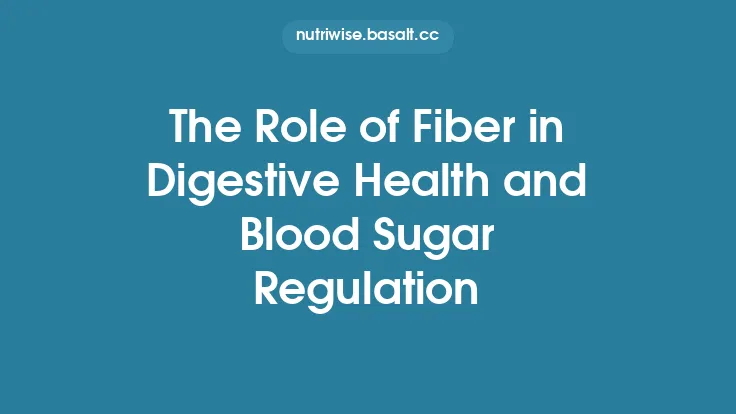The modern consumer is increasingly aware that gut health extends far beyond occasional discomfort; it is a cornerstone of overall wellness, influencing immunity, metabolism, and even mood. While probiotics—live beneficial bacteria—have long captured headlines, prebiotics—non‑digestible food components that nourish these microbes—are equally vital. Understanding how these two classes of compounds complement each other provides a more holistic approach to digestive health, allowing you to harness their combined power for lasting benefits.
Understanding Prebiotics: What They Are and How They Work
Prebiotics are selectively fermented ingredients that pass through the upper gastrointestinal tract largely intact and become substrates for beneficial bacteria in the colon. The most widely studied prebiotic fibers include inulin, fructooligosaccharides (FOS), galactooligosaccharides (GOS), and resistant starches. Their defining characteristics are:
- Resistance to Digestion – Human enzymes cannot break the β‑(2→1) linkages in these carbohydrates, so they reach the large intestine unchanged.
- Selective Fermentation – Specific bacterial groups, notably Bifidobacterium and Lactobacillus, possess the enzymatic machinery to metabolize these fibers, leading to their proliferation.
- Production of Short‑Chain Fatty Acids (SCFAs) – Fermentation yields acetate, propionate, and butyrate, metabolites that lower colonic pH, inhibit pathogenic growth, and serve as energy sources for colonocytes.
Beyond fibers, emerging prebiotic candidates such as polyphenol‑derived compounds (e.g., flavonoid glycosides) and certain oligosaccharides derived from seaweed are being investigated for their ability to modulate the microbiome in a targeted fashion.
Probiotics: Live Microorganisms and Their Functions
Probiotics are defined as “live microorganisms that, when administered in adequate amounts, confer a health benefit on the host.” The most common genera used in supplements and functional foods are *Lactobacillus, Bifidobacterium, Saccharomyces (a beneficial yeast), and Streptococcus* spp. Their primary actions within the gut include:
- Competitive Exclusion – By occupying adhesion sites on the mucosal surface, probiotics limit the ability of pathogens to colonize.
- Antimicrobial Production – Many strains secrete bacteriocins, organic acids, and hydrogen peroxide, creating an inhospitable environment for harmful microbes.
- Modulation of Host Immunity – Interaction with intestinal epithelial cells and dendritic cells can enhance the production of anti‑inflammatory cytokines (e.g., IL‑10) while dampening pro‑inflammatory pathways.
- Metabolic Contributions – Certain strains synthesize vitamins (e.g., B‑group vitamins, vitamin K) and assist in the breakdown of dietary components such as lactose.
While the specific health outcomes of a probiotic depend on the strain, the overarching principle is that these organisms act as functional members of the gut ecosystem, performing tasks that the host cannot accomplish alone.
The Symbiotic Relationship: How Prebiotics Support Probiotic Activity
The term “synbiotic” describes a formulation that deliberately pairs a prebiotic with a probiotic to achieve a synergistic effect. Even when not packaged together, the natural interaction between dietary prebiotics and resident probiotic strains is a cornerstone of a balanced microbiome. The mechanisms of this partnership include:
- Nutrient Provision – Prebiotic fibers serve as a carbon source for probiotic bacteria, enhancing their growth and survivability in the colon.
- Environmental Conditioning – SCFA production from prebiotic fermentation lowers luminal pH, favoring acid‑tolerant probiotic species while suppressing acid‑sensitive pathogens.
- Enhanced Colonization – By stimulating the proliferation of beneficial microbes, prebiotics indirectly increase the density of probiotic populations, improving the likelihood of sustained colonization after supplementation.
- Signal Modulation – Some prebiotic metabolites act as signaling molecules that up‑regulate genes involved in probiotic adhesion and biofilm formation, strengthening the physical presence of these microbes on the mucosal surface.
Thus, prebiotics can be viewed as the “fertilizer” that nurtures the “seeds” represented by probiotic organisms.
Digestive Benefits of Combining Prebiotics and Probiotics
When prebiotics and probiotics are consumed together—whether through a synbiotic product or a diet rich in both—several digestive outcomes have been consistently observed in clinical and mechanistic studies:
- Improved Bowel Regularity – The increased bulk from fermentable fibers, combined with enhanced motility driven by SCFAs, helps normalize stool frequency and consistency.
- Reduced Symptoms of Irritable Bowel Syndrome (IBS) – Trials have shown that patients receiving both components experience fewer episodes of bloating, abdominal pain, and altered stool patterns compared with either component alone.
- Enhanced Barrier Function – Butyrate, a key SCFA derived from prebiotic fermentation, strengthens tight junction proteins in the epithelium, while probiotic‑derived metabolites stimulate mucin production, together reducing intestinal permeability (“leaky gut”).
- Modulation of Gas Production – Certain prebiotic fibers are less fermentable by gas‑producing bacteria, and probiotic strains can outcompete these gas‑forming microbes, leading to lower flatulence.
- Support for Post‑Antibiotic Recovery – After a course of broad‑spectrum antibiotics, a combined regimen can accelerate the re‑establishment of a diverse, resilient microbiota, mitigating the risk of opportunistic infections such as *Clostridioides difficile*.
These benefits are not merely additive; the interaction between the two classes often yields outcomes that exceed the sum of their individual effects.
Dietary Sources vs. Supplementation: Practical Considerations
Whole‑Food Sources
- *Prebiotics*: Chicory root, Jerusalem artichoke, onions, garlic, leeks, asparagus, bananas (especially when slightly green), and whole grains such as barley and oats.
- *Probiotics*: Fermented foods like yogurt (with live cultures), kefir, sauerkraut, kimchi, miso, tempeh, and certain cheeses (e.g., Gouda, Edam).
Incorporating a variety of these foods ensures a continuous supply of both substrates and live microbes, fostering a dynamic gut environment.
Supplementation
- *Prebiotic Supplements*: Typically offered as powders or capsules containing inulin, FOS, GOS, or resistant starch. They allow precise dosing and can be added to beverages or recipes.
- *Probiotic Supplements: Contain specific strains selected for targeted health outcomes. While the focus of this article is not on strain selection, it is worth noting that many formulations include a blend of Lactobacillus and Bifidobacterium* species that are known to thrive on common prebiotic fibers.
When choosing supplements, consider factors such as the presence of clinically studied fiber types, the stability of the product throughout its shelf life, and any added ingredients that might affect tolerability (e.g., sugar alcohols).
Integration Strategy
A practical approach is to pair a prebiotic‑rich meal (e.g., a bowl of oatmeal topped with sliced banana and a sprinkle of chia seeds) with a probiotic‑containing food (e.g., a serving of kefir). For those who rely on supplements, taking a prebiotic powder with a probiotic capsule at the same meal can maximize the likelihood that the probiotic will encounter its preferred substrate shortly after reaching the colon.
Safety, Tolerability, and Potential Interactions
Both prebiotics and probiotics are generally recognized as safe for the majority of the population. However, certain considerations are important:
- Gastrointestinal Sensitivity – High doses of fermentable fibers can cause transient bloating, gas, or loose stools, especially in individuals with irritable bowel conditions. Starting with a modest amount (e.g., 2–3 g of inulin) and gradually increasing allows the microbiota to adapt.
- Immunocompromised Individuals – While rare, cases of probiotic‑related bacteremia have been reported in severely immunocompromised patients. Consultation with a healthcare professional is advisable before initiating supplementation.
- Medication Interactions – Prebiotic fibers may modestly affect the absorption of certain oral medications by altering gastric emptying time. Probiotic strains can metabolize some drugs (e.g., certain antibiotics) but this effect is typically minimal.
- Allergies and Dietary Restrictions – Some prebiotic sources (e.g., soy‑derived GOS) may trigger allergic reactions. Likewise, fermented foods can contain histamine, which may be problematic for histamine‑intolerant individuals.
Overall, a personalized approach—starting low, monitoring response, and adjusting as needed—optimizes safety while delivering benefits.
Emerging Research and Future Directions
The field of gut microbiome science is rapidly evolving, and several promising avenues are expanding our understanding of prebiotic‑probiotic synergy:
- Targeted Prebiotics (“Precision Fibers”) – Researchers are engineering oligosaccharides that selectively stimulate specific beneficial strains, such as *Akkermansia muciniphila*, which has been linked to metabolic health.
- Microbiome‑Guided Supplementation – Advances in metagenomic sequencing enable clinicians to profile an individual’s microbial composition and recommend tailored prebiotic‑probiotic combinations that address identified deficiencies.
- Postbiotic Integration – Metabolites produced by probiotic bacteria (e.g., bacteriocins, SCFAs) are being explored as therapeutic agents in their own right, potentially augmenting the effects of traditional prebiotic‑probiotic regimens.
- Gut‑Brain Axis Exploration – Preliminary studies suggest that combined prebiotic‑probiotic interventions can modulate neurotransmitter precursors (e.g., tryptophan metabolism) and reduce symptoms of anxiety and depression, opening a new frontier for mental‑health‑focused gut strategies.
These developments underscore the importance of viewing prebiotics and probiotics not as isolated supplements but as components of an integrated, dynamic ecosystem.
Practical Guidelines for Incorporating Both into Your Routine
- Assess Your Baseline – Take note of current dietary patterns, digestive symptoms, and any medical conditions that may influence tolerance.
- Start with Food – Prioritize whole‑food sources of prebiotics and probiotics; they provide additional nutrients and phytochemicals that supplements lack.
- Introduce Supplements Gradually – If dietary intake is insufficient, add a low‑dose prebiotic powder (2–3 g) and a probiotic capsule containing well‑studied strains.
- Pair Strategically – Consume prebiotic‑rich foods or supplements alongside probiotic‑containing foods or capsules within the same meal to maximize substrate availability.
- Monitor and Adjust – Track changes in stool frequency, bloating, and overall well‑being. Increase prebiotic dosage slowly if tolerated, and consider rotating probiotic strains if specific health goals evolve.
- Stay Consistent – The gut microbiome responds to regular, sustained inputs. Aim for daily inclusion rather than sporadic “detox” periods.
- Consult Professionals When Needed – For complex conditions (e.g., inflammatory bowel disease, severe dysbiosis), seek guidance from a gastroenterologist or a registered dietitian with microbiome expertise.
By following these steps, you can create a balanced, supportive environment for your gut microbes, leveraging the complementary strengths of prebiotics and probiotics to promote lasting digestive wellness.





